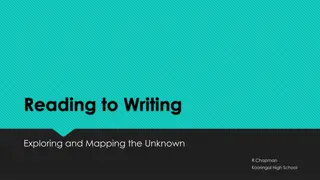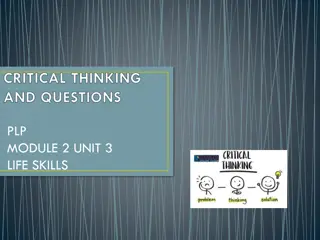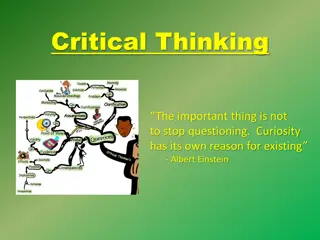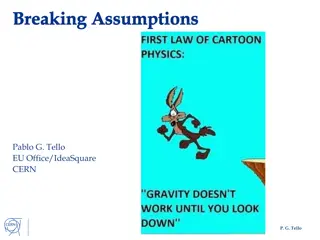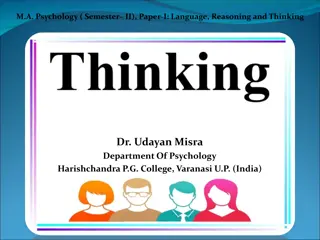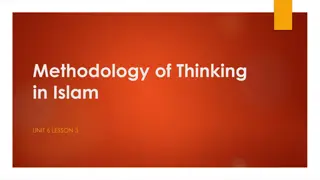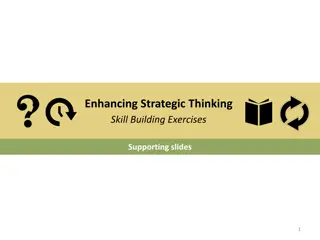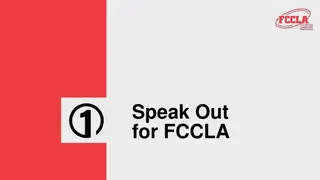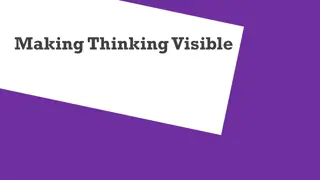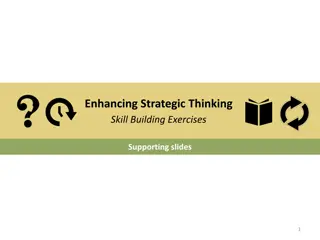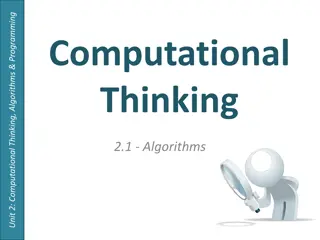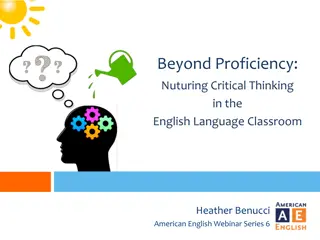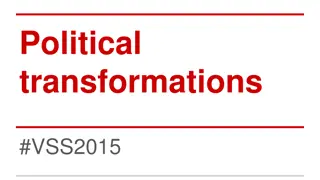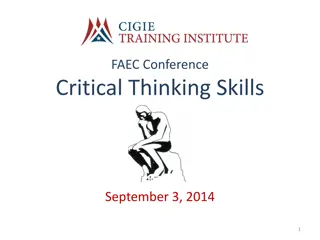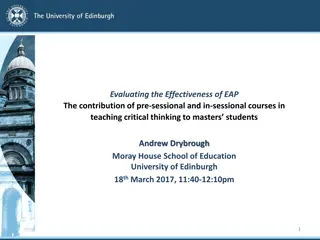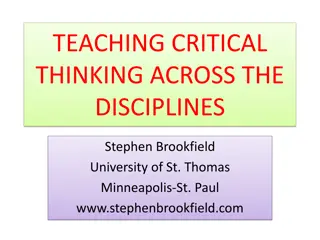Understanding Thinking & Working Politically: Key Concepts and Principles
Explore the concept of Thinking & Working Politically (TWP) through its core principles: strong political analysis, insight, understanding, local context appreciation, flexibility, and adaptability in program design. Learn why poor policies persist, the necessity of political thinking, and how TWP challenges traditional development models by emphasizing power dynamics, interests, and institutional analysis.
Download Presentation

Please find below an Image/Link to download the presentation.
The content on the website is provided AS IS for your information and personal use only. It may not be sold, licensed, or shared on other websites without obtaining consent from the author. Download presentation by click this link. If you encounter any issues during the download, it is possible that the publisher has removed the file from their server.
E N D
Presentation Transcript
Thinking & Working Politically An introduction to key ideas, examples and further reading An introduction to key ideas, examples and further reading Edward Laws and Heather Marquette Photo credit: Avel Chuklanov via Unsplash https://unsplash.com/photos/9cx4-QowgLc
Why do poor policies and dysfunctional institutions persist? The persistence of poor policy and dysfunctional institutions has less to do with a lack of knowledge or finance than with the actions of powerful actors, groups or movements who gain from existing arrangements and resist change.
Why should we think and work politically? Change is inherently political Change is complex and often unpredictable Change involves renegotiation of power and resources. It creates winners and losers, so there will always be people or groups who want to keep the status quo, and those who will welcome change because they stand to gain from it. It is very hard to know with certainty how a given project or reform process will unfold at the outset because it will involve changes in behaviour, incentives and interactions. TWP is a way to adjust the way we work to these fundamental propositions about the nature of development
What does it mean to think & work politically (TWP)? Three core principles Strong political analysis, insight, and understanding A detailed appreciation of, and response to, the local context Flexibility and adaptability in programme design and implementation In plain English Don t just say there s a lack of political will unpack this! Best fit, rather than best practice . Work with the grain, be ready to act, don t mess things up! Don t get stuck on one course of action. Test, adapt, change... you may like your model in theory but kill it if it doesn t work in practice! 4 https://twpcommunity.org/the-case-for-twp
Strong political analysis, insight, and understanding Interrogate the project and the sector with a consistent focus on power dynamics, interests, incentives, and institutions Be frank about where power resides and on whose behalf it is being used Move away from idealised models of development change, and start with contextual realities Recognise the multiple and potentially contradictory nature of interests at play in any given situation
Strong political analysis, insight, and understanding The Enabling State Programme (ESP) A 13-year, DFID-supported programme in Nepal The DFID office made a considerable effort to become involved in and informed about local politics, undertaking a thorough programme of analysis and research into the underlying causes of conflict in Nepal at the time, as well as the impact of DFID programming. The team was also able to recruit a number of well- informed, well-networked Nepali staff, who were not only politically well-informed but also skillful in navigating a charged political environment and in seizing opportunities to advance programme objectives.
A detailed appreciation of, and response to, the local context Work with and through domestic stakeholders, conveners, and power-brokers those who actually have the resources and the power to make change happen. Focus on problems identified and articulated by local actors. Understand the network of stakeholders involved and facilitate coalitions of different interests, rather than relying on one particular champion .
A detailed appreciation of, and response to, the local context The Pacific Leadership Programme (PLP) An Australian aid program supporting leaders across the Pacific Successful partly because it was open to testing new approaches to supporting locally-led change. PLP staff searched for local leaders and coalitions to lead on reforms. PLP also adopted a strong partnership approach built around cooperative agreements that supported local priorities and provided space for partners to lead their change processes. Having locally-based staff with appropriate knowledge and contacts was critical for this approach, alongside a willingness on the part of the program staff to keep a low profile and work informally behind the scenes.
Flexibility and adaptability in program design and implementation Be guided by the program goal without being overly prescriptive in how to achieve it. Clear goals should not translate into rigid project frameworks. Recognise that politics are not static. Continue to assess the local context, test original assumptions, and adapt your approach based on new information and opportunities. Periodically engage in review and reflection exercises to critique and understand what is working and what is not and stop doing what does not work.
Flexibility and adaptability in program design and implementation Facility for Oil Sector Transparency and Reform (FOSTER) A 14 million DFID-funded programme on oil and gas industry governance in Nigeria Flexibility was integrated into the design of the programme. For example, out of a total budget of 14 million, over 8.5 million was for a flexible managed fund . This allowed the programme to identify and allocate resources to initiatives as the programme went along and as political dynamics changed.
Monitoring and evaluation Traditional M&E methods track progress in linear pre-planned projects, premised on both the result and the pathway to it being known from the outset. A key part of TWP is recognising that the context surrounding programmes often changes quickly and in unpredictable ways. This complexity means that actors rarely know from the outset how exactly a given outcome can be achieved.
Monitoring and evaluation The Asia Foundation has developed an approach called Strategy Testing which involves a structured time-out every three months to reflect on programme direction and adjust approaches as needed. The FOSTER programme Iogframe holds the supplier accountable to achieve improvements in twelve areas of natural resource management, without limiting flexibility by specifying areas for engagement. The logframe used by the DFID-funded Centre for Inclusive Growth (CIG) in Nepal stipulates the number of projects to be identified and agreed at output level, without specifying the nature of these projects.
What makes for good TWP? Success factors Barriers Iterative, adaptive programme design Brokering relationships & working with the grain of local politics Politically-well informed staff who know what to do with knowledge Local actors take the lead Flexible, strategic funding Long-term commitment from funders High continuity with staffing Politically-minded staff Need full design in place from the beginning to get approval Spending targets not rooted in local reality Regular reporting against pre- approved targets External actors take the lead Unrealistic short time frames High staff turnover, no institutional memory, no proper handover Few country experts Not enough political scientists
Community of practice The TWP Community of Practice (CoP) brings together donor agencies, researchers, and practitioners to promote awareness of TWP approaches, to encourage debate, and to provide evidence-based insights that can stimulate innovation twpcommunity.org
Further reading Carothers, T. & de Gramont, D. (2013). Development aid confronts politics: The almost revolution. Washington, DC: Carnegie Endowment for International Peace. For background: Carothers and de Gramont set the scene, describing how awareness of politics has evolved since the beginnings of overseas aid in the 1950s. Booth, D. & Unsworth, S. (2014). Politically smart, locally led development. Discussion Paper. London: Overseas Development Institute. For good examples of politically-informed programmes: Booth and Unsworth analyse seven development initiatives that achieved substantial results by working in innovative and politically smart ways. Laws, E. (2018). From thinking to working politically: Reviewing the evidence on the integration of politics into development practice over the past decade. Birmingham: University of Birmingham For a critical overview of the TWP agenda and ideas for the future direction of travel: This report provides an overview and evaluation of evidence about TWP in development theory and practice.
Links @TWP_Community linkedin.com/groups/12058062 twpcommunity.org



